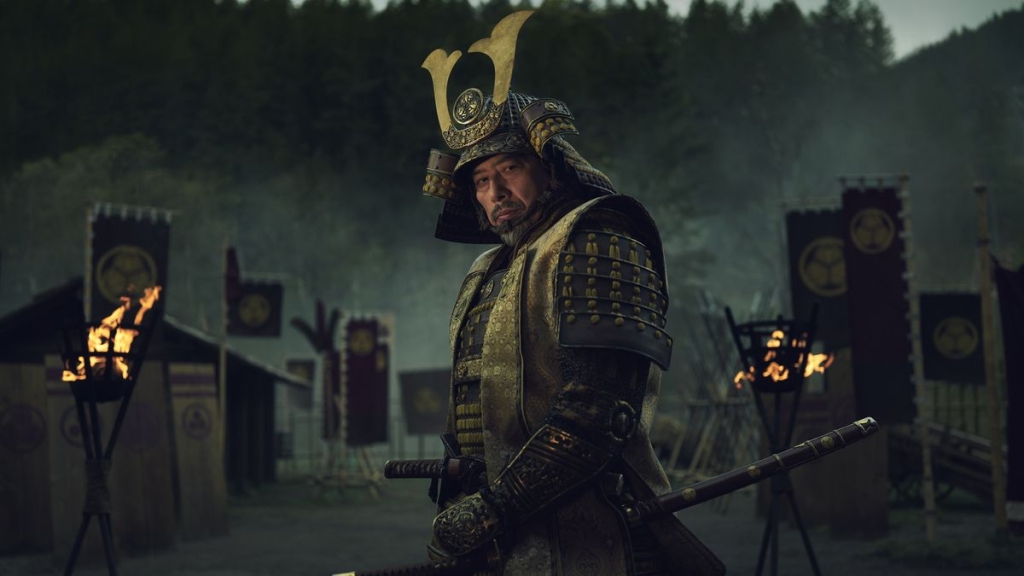Few literary works have reshaped the Western world’s knowledge of, and appreciation for, Japanese history and culture than James Clavell’s Shōgun. The best-selling novel exposed US and British (to name just two) audiences to the uniquely rich traditions of the East Asian island nation, albeit in a story that, while grounded in real-life events, is laced with cultural fetishization and historical inaccuracies.
The aim of Shōgun‘s latest TV adaptation – the first, a 1980 NBC production, captivated viewers stateside – that’ll launch on Hulu in the US and Disney Plus internationally, then, is two-fold. One, introduce Clavell’s engrossing tale to a new generation and, two, remedy the errors in his magnum opus and its TV predecessor, the latter of which was negatively received in Japan.
And it succeeds on both fronts. Educational and narratively riveting, Shōgun’s modern retelling is the kind of character-driven prestige TV that the aforementioned streamers are lacking in their show-based repertoires, and offers an impressive historical epic alternative to Disney’s franchise heavy-hitters in Marvel and Star Wars.
Worlds collide

Set in the final throes of Feudal Japan’s Sengoku period circa 1600, Shōgun primarily follows three characters whose fates become intertwined at the dawn of a century-long civil war. The most prominent of the trio is Lord Yoshii Toranaga (Hiroyuki Sanada), a powerful Bushō who rules Kanto and is fighting for his and his clan’s survival when treacherous members of the Council of Regents, which Toranaga is a part of, attempt to usurp him.
The arrival of John Blackthorne (Cosmo Jarvis), a roguish English maritime pilot and shipwreck survivor, though, further inflames the political maelstrom when Toranaga and his enemies attempt to take advantage of the geopolitical secrets he wields. With the aid of the mysterious but invaluable Lady Mariko (Anna Sawai), Toranaga and Blackthorne form an unlikely and uneasy alliance to try to maintain the fragile peace before things escalate to all-out war.
Shōgun is delightfully packed with as much double-crossing and political subterfuge
To stave off a full-scale and bloody interstate conflict, Blackthorne and his suspicious hosts must first overcome their differences. Understandably cagey about an outsider washing up on Japan’s shores, Lady Mariko, Toranaga, and the rest of his clan keep Blackthorne at arm’s length. Verbal exchanges are kept to a minimum and only necessitated when Blackthorne is required to be a political pawn in the tense game of cat and mouse between Toranaga and his foes. The ones that play out, though, are laced with the requisite suspense to heighten the mistrust that, initially at least, exists between both parties.
The absorbing nature of these chats is augmented by the effortless poise and needle that Sanada (John Wick 4, Army of the Dead) and Jarvis (Peaky Blinders) imbue their respective characters with, which set up a fascinating dynamic to come in later episodes.
Sanada is an expectedly commanding presence whenever he graces the screen as the quietly intense Toranaga, ensuring his serene aura and stoicism cuts through the burgeoning chaos that threatens to envelop his fief and wider homeland. Toranaga’s reluctance to heed calls, from both allies and Japan’s late Taikō, to assume the role of his country’s commander-in-chief – until the Taikō’s son Yaechiyo comes of age – injects a pleasing slice of 2000’s Gladiator into proceedings and acts as the fulcrum for his series-spanning character arc.

By contrast, Blackthorne’s temperamental, curt, and occasional trickster-like nature is captured with satisfyingly multidimensional intent by Jarvis. That’s not to say Sanada, Sawai, and the main supporting cast portray one-note characters – indeed, they’re just as complex. Blackthorne’s three-dimensional persona is more evident, however, by virtue of him regularly swapping between facades to stay alive in what he perceives to be a barbaric land.
My one criticism of Jarvis’ performance – and this might be something that only irritated me – is I felt that he was trying to embody two Shakespearean Marvel characters: Thor, through the British stage accent Jarvis employs, and Loki, via Blackthorne’s scoundrel-like nature. Shōgun‘s Sengoku period ran concurrent to Shakespearean England, but Jarvis’ lilt and mannerisms seem like they draw inspiration from two of the MCU’s most notable characters, rather than real-world history. An exaggerated problem on my part? Maybe, but one I nonetheless found distracting.
Verbal exchanges are… laced with the requisite suspense to heighten the mistrust
Sawai’s portrayal of Lady Mariko shouldn’t be overlooked, mind you. The Monarch: Legacy of Monsters star proved she had the talent to lead an ensemble cast in Apple TV Plus’ aforementioned Godzilla TV show, and she showcases those capabilities here as one of Shōgun‘s co-leads. Sawai is an ethereal presence who brings a delightful mystique and fortitude to the enigmatic Mariko, and I can’t wait to learn more about her cryptic backstory in future episodes.
Make no mistake, Shōgun might position its male cast as the de-facto mainstays of its plot – an expected move, yes, given the gender inequality that majorly existed at the time. But, as particularly evidenced in her first big scene with Sanada, among others in the first two entries, Sawai is a shoo-in to be the series’ consummate surprise package.
Power plays

A series like Shōgun wouldn’t work as an engrossing, tension-riddled historical drama if its ensemble cast of characters were a harmonious bunch. It’s a good thing, then, that this isn’t the case. From Toranaga’s adversaries among the Council of Regents members, including Ishido Kazunari (Takehiro Hira), to duplicitous warriors in his own ranks like Kashigi Yabushige (Tadanobu Asano), Shōgun is full of deceitful individuals with self-serving motives.
A collection of characters as complicated and narcissistic as this lot makes for delicious melodrama and politicking on a par with Game of Thrones, albeit one anchored in real-life history rather than HBO’s live-action adaptation of George R.R. Martin’s beloved fantasy book series. Shōgun is delightfully packed with as much double-crossing and political subterfuge as its Max-based contemporary; the envious Ishido leading his fellow council members in trying to oust Toranaga as he looks to seize power. Fans of Thrones and its prequel series House of the Dragon, as well as similar politically-minded historical shows like Vikings: Valhalla, will find an abundance of histrionics to gorge on.
Shōgun curries favor with viewers of an ultraviolent disposition with a handful of obligatory brutal scenes
Where terse or frank discussions won’t do, Shōgun isn’t afraid to step into cold-hearted, merciless territory. Like Thrones and Blue Eye Samurai – Netflix’s R-rated animated series set during Japan’s Edo period – Shōgun curries favor with viewers of an ultraviolent disposition with a handful of obligatory brutal scenes. Such moments are rare in its opening episodes, but it makes them all the more callous and shocking upon their unexpected arrival. And I’m not only talking about beheadings or similarly bloody sequences, either – indeed, a scene in episode one, which sees one of Blackthorne’s crew boiled alive in a vat of boiling water and soy, is as harrowing as it sounds.

The trepidation felt by Japanese natives towards outsiders, as well as their cut-throat approach to dealing with those who hope to hoodwink them, is to be expected. Racial and religious intolerance was rife across the globe in the 17th century, and Shōgun isn’t afraid to demonstrate the level of xenophobia from all sides amid its wider narrative. It makes for uncomfortable viewing, yes, but adds to the mandatory realism that showrunners Rachel Kondo and Justin Marks, in partnership with Clavell’s daughter Michaela (an executive producer on the show) wish to highlight as part of Shōgun’s authentic portrayal and historical accuracy of this period.
If there are elements to nit-pick at, it’s Shōgun’s action-oriented sequences and occasionally heavy plot exposition. The latter is most prominent in episode two, with characters practically spelling out plans devised by Toranaga and Ishido verbatim; moments that – although some will say it’s done without looking to offend anyone – insult viewers’ intelligence to determine what’s going on themselves.
As for the early episodes’ set-pieces, they’re pretty lackluster. A high seas-situated storm sequence is certainly intense and admirably showcases Shōgun’s high production value and cinematic execution, but it abruptly ends just as it’s really getting going. The same criticism can be leveled at episode two’s final scene; a bloody assassin-based scenario that’s disappointingly fleeting in its ruthlessness and stunt work.
My verdict
It can be challenging to judge the merits of a new series based on its first two episodes alone, but Shōgun has the air of a sublime historical epic whose ambitious scope and scale has paid off. Its weighty and beguiling drama that’s ripped right out of the shogunate playbook, coupled with how it presents one of the most important periods in Japan’s chaotic history, ensures it’s off to a captivatingly dependable start.
Its heady mix of political intrigue and barbarity requires some refinement heading into its next six episodes, but it does a purposeful job of ironing out the arguably outdated elements of Clavell’s source material. I’m sure some fans of his novel will question whether such creative deviations were necessary, however, given the era Shōgun is set in.
Understandably, parallels will be drawn between Shōgun and Game of Thrones – plus, given its setting and similar time frame, other western world-developed productions like Blue Eye Samurai. Regardless, Shōgun succeeds in being a large-scale production with a pleasing narrative confluence that proves two of the world’s best streaming services (Hulu and Disney Plus) can supply high-quality, big-budget shows for their userbases. If Shōgun builds on its first installments to deliver an entertaining and enthralling slice of prestige TV, I’ll need no second invitation to add it to our best Hulu shows and best Disney Plus shows guides.
Shōgun debuts with a two-episode premiere on Tuesday, February 27. New episodes air weekly until the finale on Tuesday, April 23.














